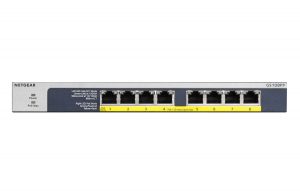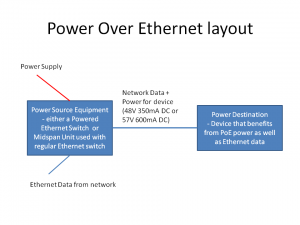NETGEAR offers an affordable 8-port Gigabit unmanaged switch with Power Over Ethernet Plus on all ports
From the horse’s mouth
NETGEAR
GS108PP 8-port Gigabit unmanaged switch with Power Over Ethernet Plus
Special Offer
MWAVE deal on this switch for AUD$169
Related Coverage
Understanding Power Over Ethernet
My Comments
Increasingly Power-Over-Ethernet technology is being offered as a product-differentiating feature for small-business and installer-grade Ethernet switches. This is where these switches are able to supply power to network devices using the same blue wire that connects them to the wired Ethernet network.
The feature is appealing towards Wi-Fi access points, VoIP desk telephones and IP-based videosurveillance cameras as a way to power them without having to locate a power outlet near these devices. It also provides a form of central power control for such devices such as assuring access to battery backup for a cluster of devices or to allow a managed Ethernet switch to provide programmatic power control from its user interface.
But a lot of them offer this technology to some, usually half, of the ports available on them. TrendNET previously offered to the American market an eight-port Gigabit unmanaged switch with Power-Over-Ethernet Plus on all ports for US$280 when it came out.
But NETGEAR are offering the GS108PP switch which is a similar device with Power-Over-Ethernet Plus on all eight Gigabit ports for AUD$219 recommended retail price. MWAVE, an independent online computer dealer serving the Australian market. has put downward pressure on the price of this device class offering this Netgear unit with a 123W total power budget for a street price of AUD$169. As well, this model can be mounted on a desktop or a wall thanks to keyhole slots on the side but also comes with a set of rack ears to permit installation in a standard equipment rack.
It has been something associated with NETGEAR where they have offered affordable network-infrastructure hardware fit for small networks. This was primarily in the form of highly-compact affordable five-port and eight-port Ethernet switches with the basic expectations of their era. Gradually as newer network standards came along, NETGEAR would eventually be the first to roll them in to these affordable five-port or eight-port devices. Let’s not forget that they offered managed Ethernet switches that implement Web-based management and “automatic-transmission” operation for quality-of-service management when it comes to voice or video traffic. There was even the Nighthawk S8000 Gaming and Multimedia Switch with the same abilities as one of these business-grade switches but in a housing that would please gamers or not look out of place in a home-entertainment centre.
The next step for NETGEAR to take with some of these technologies is to package and present them to appeal to home users and small businesses while making them affordable. It can also be about endorsing and supporting connectivity and management standards that permit simplified setup of Ethernet-based network infrastructure.


